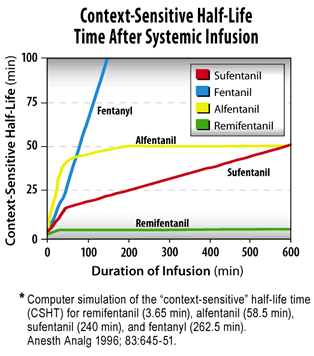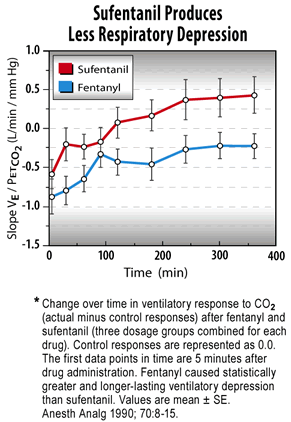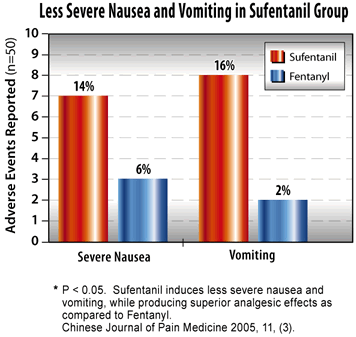| Download Sufentanil Brochure | Download Package Insert | Printer Friendly Product Info |
Safety
Continuous Infusion – Sufentanil does not accumulate in the tissues.

Sources: Anesthesiology (1991) Jan; 74(1):53-63
Glass PSA, Pharmacology of remifentanil. European Journal of Anaesthesiology, 1995, 12(Suppl. 10):73-74
Ventilatory Depression – Sufentanil has low impact on circulatory system, producing less ventilatory depression than Fentanyl.

Source : Bailey PL, Streisand JB, East KA, et al. Differences in magnitude and duration of opioid-induced respiratory depression and analgesia with fentanyl and sufentanil. Anesth Analg 1990; 70:8-15.
Nausea and Vomiting – Sufentanil induces less severe nausea and vomiting, while producing superior analgesic effects as compared to Fentanyl.

PCEA | Fentanyl Group | Sufentanil Group |
Drug | 0.12% ropivacaine+2ug/ml Fentanyl | 0.12% ropivacaine+0.5ug/ml Sufentanil |
Dose | basal dose:4ml/h, PCA dose: 2ml, lockout time: 20min | |
Source: Yao Tong, Wu Xin-Min, Yang Shun-Wei. Postoperative PCEA with Sufentanil plus ropivacaine. Chinese Journal of Pain Medicine 2005, 11, (3)
Extrahepatic Metabolism – Total and hepatic clearance significantly higher in patients administered Sufentanil for orthotopic liver transplantation (OLT)

Source: Marc Raucoules, Michel Kaidomar, et al., Hepatic disposition of alfentanil and sufentanil in patients undergoing orthotopic liver transplantation. Anesth Analg 1997; 84:1019-24


